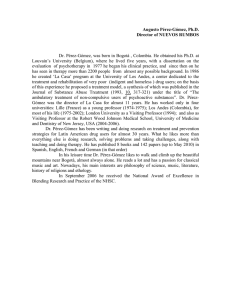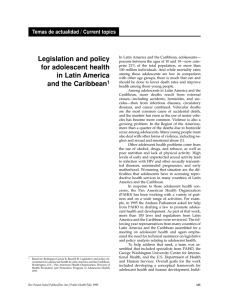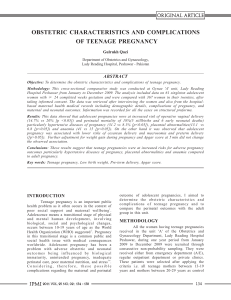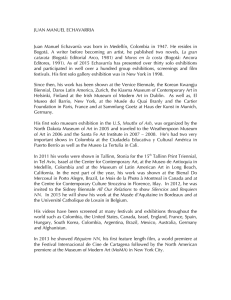Risk factors for adolescent pregnancy in Bogotá, Colombia, 2010: a
Anuncio
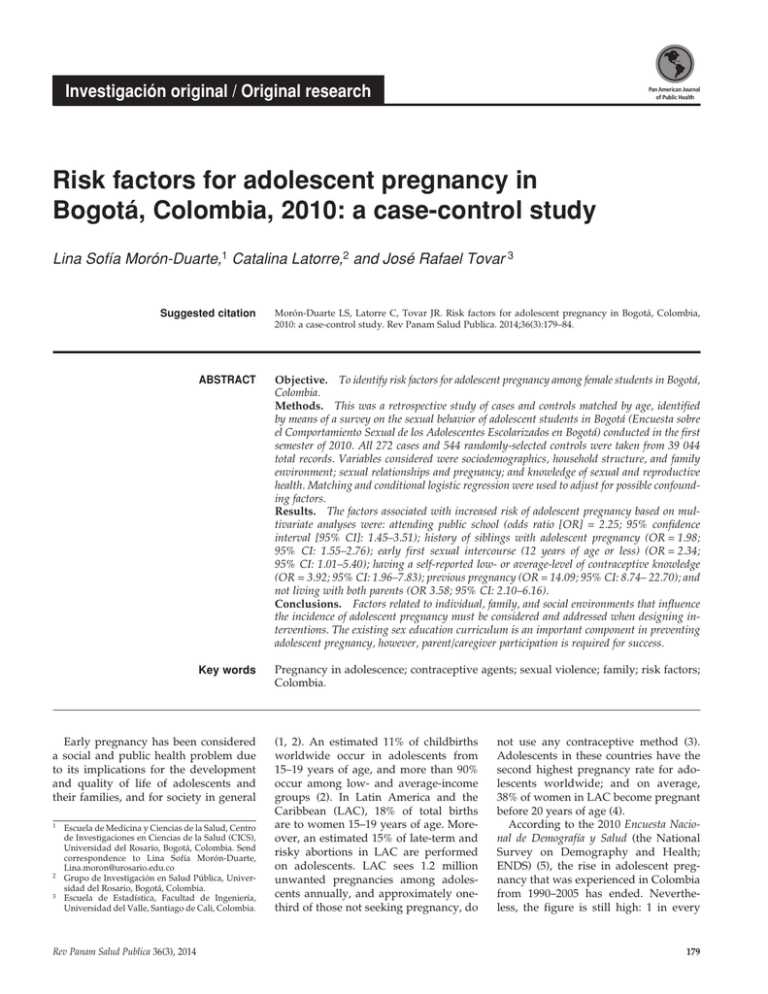
Investigación original / Original research Pan American Journal of Public Health Risk factors for adolescent pregnancy in Bogotá, Colombia, 2010: a case-control study Lina Sofía Morón-Duarte,1 Catalina Latorre,2 and José Rafael Tovar 3 Suggested citation Morón-Duarte LS, Latorre C, Tovar JR. Risk factors for adolescent pregnancy in Bogotá, Colombia, 2010: a case-control study. Rev Panam Salud Publica. 2014;36(3):179–84. abstract Objective. To identify risk factors for adolescent pregnancy among female students in Bogotá, Colombia. Methods. This was a retrospective study of cases and controls matched by age, identified by means of a survey on the sexual behavior of adolescent students in Bogotá (Encuesta sobre el Comportamiento Sexual de los Adolescentes Escolarizados en Bogotá) conducted in the first semester of 2010. All 272 cases and 544 randomly-selected controls were taken from 39 044 total records. Variables considered were sociodemographics, household structure, and family environment; sexual relationships and pregnancy; and knowledge of sexual and reproductive health. Matching and conditional logistic regression were used to adjust for possible confounding factors. Results. The factors associated with increased risk of adolescent pregnancy based on multivariate analyses were: attending public school (odds ratio [OR] = 2.25; 95% confidence interval [95% CI]: 1.45–3.51); history of siblings with adolescent pregnancy (OR = 1.98; 95% CI: 1.55–2.76); early first sexual intercourse (12 years of age or less) (OR = 2.34; 95% CI: 1.01–5.40); having a self-reported low- or average-level of contraceptive knowledge (OR = 3.92; 95% CI: 1.96–7.83); previous pregnancy (OR = 14.09; 95% CI: 8.74– 22.70); and not living with both parents (OR 3.58; 95% CI: 2.10–6.16). Conclusions. Factors related to individual, family, and social environments that influence the incidence of adolescent pregnancy must be considered and addressed when designing interventions. The existing sex education curriculum is an important component in preventing adolescent pregnancy, however, parent/caregiver participation is required for success. Key words Pregnancy in adolescence; contraceptive agents; sexual violence; family; risk factors; Colombia. Early pregnancy has been considered a social and public health problem due to its implications for the development and quality of life of adolescents and their families, and for society in general 1Escuela de Medicina y Ciencias de la Salud, Centro de Investigaciones en Ciencias de la Salud (CICS), Universidad del Rosario, Bogotá, Colombia. Send correspondence to Lina Sofía Morón-Duarte, [email protected] 2Grupo de Investigación en Salud Pública, Universidad del Rosario, Bogotá, Colombia. 3 Escuela de Estadística, Facultad de Ingeniería, Universidad del Valle, Santiago de Cali, Colombia. Rev Panam Salud Publica 36(3), 2014 (1, 2). An estimated 11% of childbirths worldwide occur in adolescents from 15–19 years of age, and more than 90% occur among low- and average-income groups (2). In Latin America and the Caribbean (LAC), 18% of total births are to women 15–19 years of age. Moreover, an estimated 15% of late-term and risky abortions in LAC are performed on adolescents. LAC sees 1.2 million unwanted pregnancies among adolescents annually, and approximately onethird of those not seeking pregnancy, do not use any contraceptive method (3). Adolescents in these countries have the second highest pregnancy rate for adolescents worldwide; and on average, 38% of women in LAC become pregnant before 20 years of age (4). According to the 2010 Encuesta Nacional de Demografía y Salud (the National Survey on Demography and Health; ENDS) (5), the rise in adolescent pregnancy that was experienced in Colombia from 1990–2005 has ended. Nevertheless, the figure is still high: 1 in every 179 Original research 5 Colombian teenagers (15–19 years of age) has been pregnant at some time; 16% are already mothers; and 4% are expecting their first child (5). Although the data shows a downward trend in adolescent pregnancy, the current figures are still too high and continue to be of social and political concern (6, 7). Many factors related to adolescent pregnancy have been identified (8). Studies show that risk behaviors of pregnant adolescents are interrelated with surrounding contextual and socioeconomic factors, e.g., education and poverty (9–12). The adolescent’s family plays an important role in the risk of an early pregnancy: living with a single parent/guardian; having a mother with a low level of education; and having a sibling with history of adolescent pregnancy have all been reported as significant risk factors for adolescent pregnancy (13, 14). Risk behavior has also been associated with low supervision and family support (9), as well as nonfunctional families with low levels of communication (15). Other risk factors that impact adolescent sexual and reproductive health are lack of knowledge on contraceptives, early initiation of sexual intercourse (16, 17), and having suffered sexual abuse in childhood and/or adolescence (18, 19). A review of the literature shows a substantial number of studies reporting multiple factors associated with adolescent pregnancy; however, recent studies focusing on the issue in Colombia are limited. Therefore, to properly inform and implement any interventions in Colombia, a study was needed to understand the specific circumstances and contexts in which the adolescent in Colombia, her parents, and teachers may better respond to reduce the risk of early pregnancy. The present study aimed to meet this need by identifying risk factors for adolescent pregnancy among female students in the city of Bogotá in 2010. MATERIALS AND METHODS Study design A retrospective study of cases and controls (1:2) was conducted. A case was defined as any adolescent from 14–19 years of age that was pregnant at the time of the survey; controls were those who had never been pregnant. The cases and controls were matched by age (stan- 180 Morón-Duarte et al. • Risk factors for adolescent pregnancy in Bogotá dard deviation [SD] +/–1) and type of school (public or private). The required sample size was 192 cases and 385 controls, based on the 15.3% rate of adolescent pregnancy reported by the Primera Encuesta Distrital de Demografía y Salud en Bogotá (First District Survey of Demographics and Health in Bogotá) in 2011 (20) and an expected odds ratio of 2.4, confidence intervals of 95%, and a power of 80%. Cases and controls were selected according to data from the 2010 Encuesta Comportamiento Sexual de Adolescentes Escolarizados en Bogotá (Survey on the Sexual Behavior of Adolescent Students in Bogotá; ECSAE), specifically the 60 questions on sexual behavior applied to 39 040 adolescent students in Bogotá (21, 22). Survey records provided more than the required sample size: 272 cases and 544 controls, with the cases being the total number of cases in the database and the control group taken randomly. Study instrument and variables The 60 items on the ECSAE are grouped into five sections: (i) sociodemographic, household structure, and family environment; (ii) access to and use of school subsidies; (iii) sexual relationships, pregnancy, and knowledge of sexual and reproductive health; (iv) institutional climate and characteristics of the household environment; and (v) social stigma for pregnant adolescents. The present study used responses to questions in the first (i) and third (iii) sections. The variables considered by this study were: attending a public or private school; age at first sexual intercourse; whether first intercourse was consensual or not; living with parents; history of a sibling with adolescent pregnancy; age of respondent’s mother at first childbirth; school level at which sex education was received (preschool and primary/middle/high school); parental control over access to reproductive health services; self-report on extent of contraceptive knowledge; and record of previous pregnancies. Data analysis Statistical data analyses comprised a bivariate analysis, odds ratios (OR) with 95% confidence intervals (95% CI), and chi square tests to establish associations between variables. For any variable with an important statistical and contextual association, a model of conditional logistic regression was adjusted, with 0.05 as the maximum type I error permitted. Study ethics This study was conducted in accordance with national legislation on health research (23), based on international law and the Declaration of Helsinki revised in Brazil in 2013 (24). The study did not employ any directly mediated data collection, and its methods respected the principles of confidentiality, e.g., individual identity was protected and there were no personal interviews. RESULTS In total, 272 cases and 544 controls were included. The mean age of the cases was 16.28 years ± 1.15, and of controls, 15.88 years ± 1.10. As for the sociodemographic variables, it was found that adolescents in public schools had a greater risk (OR = 2.26; 95% CI: 1.42–3.65) of pregnancy than those in private schools. Another factor associated with adolescent pregnancy was the absence of both parents in the family nucleus (OR = 3.56; 95% CI: 2.08–6.09). No statistically significant association was observed between nonconsensual sexual intercourse and pregnancy in adolescence (OR = 1.24; 95% CI: 0.62–2.45) (Table 1). Analysis of sexual and reproductive health variables showed that having a sibling with a history of adolescent pregnancy was associated with the number of times a respondent in the case group had been pregnant (OR = 1.87; 95% CI: 1.35–2.59). Also associated with adolescent pregnancy were first intercourse at 12 years of age or less (OR = 2.32; 95% CI: 0.94–5.72) and having an average or poor self-report of contraceptive knowledge (OR = 1.81, 95% CI: 1.31–2.49; OR = 3.02; 95% CI = 1.46–6.28). Regarding whether the respondent had been pregnant in the year prior to completing the questionnaire, 39.6% of the case group responded affirmatively, versus 4.4% of the controls (OR = 14.1; 95% CI: 8.55–23.39). As for other variables, such as having a mother with a history of adolescent pregnancy, the school level at which sex education was received, and parental control of access to reproductive health services, no association was found (Table 2). Rev Panam Salud Publica 36(3), 2014 Morón-Duarte et al. • Risk factors for adolescent pregnancy in Bogotá Original research TABLE 1. Bivariate analysis of sociocultural variables identified as risk factors for adolescent pregnancy in Bogotá, Colombia, 2010 Cases (n = 272)a Controls (n = 544)a No. % No. % Odds ratio 95% CIb (range) P valuec Public school No Yes 28 244 10.3 89.7 112 432 20.6 79.4 1.00 2.26 1.42–3.61 < 0.001 Nonconsensual (forced) sexual intercourse No Yes 255 14 32.9 37.8 521 23 67.1 62.2 1.00 1.24 0.62–2.45 0.592 Parental presence/absence Both present One present Both absent 109 129 34 40.1 47.4 12.5 258 251 35 47.4 46.1 6.4 1.00 1.05 3.56 0.78–1.42 2.08–6.09 0.728 < 0.001 Risk factor a Totals of some variables may differ due to missing values. confidence interval. value associated with Pearson’s chi square test. b 95% c P TABLE 2. Bivariate analysis of sexual and reproductive health variables as risk factors for adolescent pregnancy in Bogotá, Colombia, 2010 Cases (n = 272)a Controls (n = 544)a No. % No. % Odds ratio 95% CIb (range) P valuec Sibling with history of adolescent pregnancy No Yes 145 105 27.0 40.9 392 152 59.1 73 1.00 1.87 1.35–2.59 < 0.001 Mother (of adolescent) with history of pregnancy ≤ 19 years of age No Yes 76 112 40.4 59.6 254 290 46.7 53.3 1.00 1.29 0.92–1.80 0.149 School level at which sex education received Preschool and primary school Middle school High school 36 20 125 19.1 11 69.1 82 38 262 21.5 9.9 68.6 1.00 1.12 1.02 0.61–2.06 0.69–1.53 0.687 0.909 Age at first sexual intercourse ≥ 16 years 13 –15 years ≤ 12 years 46 183 12 19.1 75.9 5.0 93 393 11 18.7 79.1 2.2 1.00 0.83 2.32 0.57–1.22 0.94–5.72 0.333 0.042 Parental control over access to reproductive health services Yes No 214 33 86.6 13.4 436 58 88.3 11.7 1.00 0.86 0.53–1.40 0.526 Self-report on extent of contraceptive knowledge Good Fair Poor 131 110 21 50 42 8 367 153 15 68.6 28.6 2.8 1.00 1.81 3.02 1.31–2.49 1.46–6.28 < 0.001 < 0.001 History of prior pregnancy(ies) No Yes 162 106 60.4 39.6 517 24 95.6 4.4 1.00 14.10 8.55–23.39 < 0.001 Risk factor a The totals of some variables may vary due to missing values. confidence interval. value associated with Pearson’s chi square test. b 95% c P Multivariate conditional analysis (­ Table 3) showed that the six risk factors (public school; early first intercourse; sibling with adolescent pregnancy; parental Rev Panam Salud Publica 36(3), 2014 absence; poor contraceptive knowledge; and previous pregnancy) identified as being associated in the bivariate analysis remained significant; however, the variables “previous pregnancy” and “inadequate knowledge of contraceptive methods” were the factors most associated adolescent pregnancy. 181 Original research Morón-Duarte et al. • Risk factors for adolescent pregnancy in Bogotá TABLE 3. Multivariate analyses of the risk factors associated with adolescent pregnancy in ­Bogotá, Colombia, 2010 Odds ratioa 95% CIb (range) Public school No Yes 1.00 2.25 1.45–3.51 < 0.001 Parental presence/absence Both present One present Both absent 1.00 1.03 3.58 0.77–1.51 2.10–6.16 0.823 < 0.001 Sibling with history of adolescent pregnancy No Yes 1.00 1.98 1.55–2.76 < 0.001 Age at first sexual intercourse ≥ 16 years 13 – 15 years ≤ 12 years 1.00 2.20 2.34 0.90–5.37 1.01–5.40 0.082 0.046 Self-report on extent of contraceptive knowledge Good Fair Poor 1.00 1.94 3.92 0.96–3.94 1.96–7.83 0.064 < 0.001 1.00 14.09 8.74–22.70 < 0.001 Risk factor History of pregnancy(ies) No Yes P valuec a Odds ratio adjusted for all variables in the table. confidence interval. c P value associated with Pearson’s chi square test. b 95% DISCUSSION Obviously there are both contextual and socioeconomic factors that constitute risks for adolescent pregnancy. The associations found in this work between previous pregnancy and family history of adolescent pregnancy and the respondent’s pregnancies, as well as some risk behaviors for health, concur with those of other research (9–19). This study found that attending public school represents a greater risk for adolescent pregnancy, noting that school type is generally related to socioeconomics. Again, these findings are quite similar to those reported by other ­ studies (9–19). This study’s findings regarding the risk of pregnancy in adolescents who experienced the absence of both parents from the nuclear family—not for those with a single parent—agree with what was reported by Goicolea and colleagues (19); however, a study by Lee (25) reported that adolescents from single-parent families were also at risk of pregnancy (adjusted OR = 4.8; 95% CI: 1.4–16.1). 182 On the other hand, this study did not find a significant association between adolescent pregnancy and nonconsensual sexual intercourse. This finding contradicts that of another study, which reported that adolescent victims of sexual or physical abuse had a significantly greater risk of pregnancy than those without a history of abuse (18). This result should be interpreted cautiously given that the question of forced sexual intercourse can be emotionally complex; therefore, it was possibly underreported. This factor should be further explored using other methods, such as in-depth interviews, where answers may be given more candidly. Characteristics of first sexual intercourse also influenced the risk of adolescent pregnancy. Starting sex early (< 12 years of age) was significant in our study, similar to the findings of other authors (9, 16, 17). Lack of contraceptive use during first sex was also found to be a risk for adolescent pregnancy (OR = 4.19; 95% CI: 3.04–5.77). Similar results were reported by Goicolea and colleagues (OR = 4.30; 95% CI: 1.33–13.90) and Lee and colleagues (adjusted OR = 3.1; 95% CI: 1.3–7.2) (19, 25). Nonuse of contraceptive at first sex could be due to a lack of knowledge, specifically a false sense of security based on a perceived low or nonexistent risk of pregnancy. According to self-reported degree of knowledge regarding contraceptive methods, the study findings showed that when knowledge is deficient, the risk of adolescent pregnancy is greater. Moni and colleagues (26) also reported a strong association between lack of sexual and reproductive health knowledge and adolescent pregnancy (OR = 4.95; P = 0.0003). In addition, we found that adolescents reporting a history of pregnancy had a risk 14.1 times greater of becoming pregnant again than those who reported never having been pregnant. These study results also showed that having a sibling who had given birth in adolescence was a risk factor for adolescent pregnancy. We also looked for a possible association between adolescent pregnancy and having a mother with a history of childbirth at 19 years of age or less. This study showed no significant association and neither did the study by Goicolea and colleagues (19). Neverthe- Rev Panam Salud Publica 36(3), 2014 Morón-Duarte et al. • Risk factors for adolescent pregnancy in Bogotá less, other studies, such as Amorin and colleagues (OR = 2.6; 95% CI = 1.7–3.4) and Lee (adjusted OR = 4.9; 95% CI: 2.2–11.0) found that having a history of a mother with adolescent pregnancy represents a risk (25, 27). Study limitations A limitation of this study was that the data came from self-reports of minors, and was therefore, subject to recall bias, and this bias that may not have been equally distributed between cases and controls. Nevertheless, the bias may have been minimal since the questionnaire was administered individually and anonymously in a controlled environment with identical questions for both groups. Also, other variables, such as educational status, might have been included as possible confounders. However, we did not consider educational status since the sample came from public and private schools in the same neighborhoods of Bogotá with same sociodemographic context and very similar poverty conditions. It could be assumed that the quality of the education was similar. Note that in Colombia, poor parents often pay for private school because their neighborhood public schools are over capacity. Original research Conclusion In Bogotá, Colombia, attending a public school, early sexual initiation, not living with both parents, and ignorance of contraceptive methods are all associated with pregnancy in adolescents. These factors, all related to complex individual, family, and social environments, must be considered and addressed when designing interventions. Implementing sex education, including contraceptive methods, as part of the school curriculum is an important step, but parent/guardian involvement is indispensable as well. Conflict of interest: None. REFERENCES 1.World Health Organization. Health topics: adolescent health. Available from: www.who. int/topics/adolescent_health/en/ Accessed on 10 September 2014. 2. World Health Organization. WHO guidelines on preventing early pregnancy and poor reproductive outcome among adolescents in developing countries. Geneva: WHO; 2011. 3. Organización Panamericana de la Salud. El Día Internacional de la Niña: aboga por terminar con el matrimonio infantil que contribuye a embarazos tempranos y no planificados. Avail­ able from: http://new.paho.org/hq/index. php?option=com_content&view=article&id= 7322&itemid=1&lang=es Accessed on 28 May 2013. 4. Fondo de las Naciones Unidas para la Infancia. Hechos sobre adolescencia y jóvenes en América Latina y el Caribe. Available from: www.unicef.org/lac/Fast_facts_SP(1).pdf. Accessed on 10 September 2014. 5.Profamilia, Ministerio de Protección Social, Instituto Colombiano de Bienestar Familiar, United States Agency for International Development. Encuesta de Demografía y Salud. Bogotá, Colombia: Printex Impresora; 2011. 6. Quintero F, Pacheco CI. Participar para prevenir, sistematización de la experiencia de los consejos de adolescentes y jóvenes para la prevención del embarazo adolescente no planificado. Madrid: Organización Iberoamericana de Juventud; 2012. 7.Departamento Nacional de Planeación. Documento Conpes Social. Lineamientos para el desarrollo de una estrategia para la prevención del embarazo en la adolescencia y la promoción de proyectos de vida para los niños, niñas, adolescentes y jóvenes en edades entre 6 y 19 años. Bogotá, Colombia: DNP; 2012. 8. World Health Organization. Adolescent pregnancy. Available from: www.who.int/media centre/factsheets/fs364/en/# Accessed on 11 September 2014. 9.Flórez CE. Factores socioeconómicos y contextuales que determinan la actividad repro- Rev Panam Salud Publica 36(3), 2014 ductiva de las adolescentes en Colombia. Rev Panam Salud Publica. 2005;18(6):388–402. 10. United Nations Population Fund. Adolescent pregnancy: a review of the evidence. New York: UNFPA; 2013. 11. South SJ, Crowder K. Neighborhood poverty and nonmarital fertility: spatial and temporal dimensions. J Marriage Fam. 2010;72(1): 89–104. 12.Banco Internacional de Reconstrucción y Fomento/Banco Mundial. Embarazo adolescente y oportunidades en América Latina y el Caribe. Sobre maternidad temprana, pobreza y logros económicos. Washington, DC: World Bank; 2012. 13. Martinez G, Copen CE, Abma JC. Teenagers in the United States: sexual activity, contraceptive use, and childbearing, 2006–2010. National Survey of Family Growth. Vital Health Stat. Hyattsville: U.S. Centers for Disease Control and Prevention; 2011. 14.East PL, Reyes BT, Horn EJ. Association between adolescent pregnancy and a family history of teenage births. Perspect Sex Reprod Health. 2007;39(2):108–15. 15.Peres CA, Rutherford G, Borges G, Galano E, Hudes ES, Hearst N. Family structure and adolescent sexual behavior in a poor area of Sao Paulo, Brazil. J Adolesc Health. 2008; 42(2):177–83. 16. Smid M, Martins S, Whitaker AK, Gilliam M. Correlates of pregnancy before age 15 compared with pregnancy between the ages of 15 and 19 in the United States. Obstet Gynecol. 2014;123(3):578–83. 17. Mmari K, Sabherwal S. A review of risk and protective factors for adolescent sexual and reproductive health in developing countries: an update. J Adolesc Health. 2013;53(5):562–72. 18.Madigan S, Wade M, Tarabulsy G, Jenkins JM, Shouldice M. Association between abuse history and adolescent pregnancy: a metaanalysis. J Adolesc Health. 2014;55(2):151–9. 19. Goicolea I, Wulff M, Öhman A, San S­ ebastian M. Risk factors for pregnancy among adolescent girls in Ecuador’s Amazon basin: a case- control study. Rev Salud Publica. 2009;26(3): 221–8. 20.Alcaldía Mayor de Bogotá, Profamilia. 1a Encuesta Distrital de Demografía y Salud. Bogotá: Alcaldía Mayor de Bogotá; 2011. 21. Cortés D, Gallego J, Maldonado D. On the design of education conditional cash transfer programs and noneducation outcomes: the case of teenage pregnancy. Facultad de economía. Universidad del Rosario. Available from: www. urosario.edu.co/economia/documentos/ pdf/dt100.pdf Accessed on 14 October 2014. 22.Programs and non education outcomes: the case of teenage pregnancy. Serie documentos de trabajo. Número 100. Facultad de economía. Universidad del Rosario. Available from: www.urosario.edu.co/economia/ documentos/pdf/dt100.pdf Accessed on 14 October 2014 23. Ministerio de Salud y Protección Social. Resolución Número 8430, 1993. Available from: www.minsalud.gov.co/Normatividad/ RESOLUCION%208430%20DE%201993.pdf Accessed on 10 October 2014. 24.World Medical Association. WMA Declaration of Helsinki: Ethical Principles for Medical Research Involving Human Subjects. Available from: www.wma.net/en/ 30publications/10policies/b3/index.html Accessed on 10 October 2014. 25. Lee M-C. Family and adolescent childbearing. J Adolesc Health. 2001;28:(4):307–12. 26.Moni SA, Nair MKC, Devi RS. Pregnancy among unmarried adolescents and young adults. J Obstet Gynaecol (India). 2013;63(1): 49–54. 27. Amorim MMR, Lima LA, Lopes CV, Araújo DKL, Silva JGG, César LC, et al. Risk factors for pregnancy in adolescence in a teaching maternity in Paraíba: a case-control study. Rev Bras Ginecol Obstet. 2009;31(8):404–10. Manuscript received on 10 March 2014. Revised version accepted for publication on 25 September 2014. 183 Original research Morón-Duarte et al. • Risk factors for adolescent pregnancy in Bogotá resumen Factores de riesgo de embarazo adolescente en Bogotá, Colombia, 2010: estudio de casos y testigos Palabras clave 184 Objetivo. Identificar los factores de riesgo de embarazo adolescente entre las estudiantes de Bogotá, Colombia. Métodos. Estudio retrospectivo de casos y testigos pareados por edad e identificados por medio de una encuesta sobre el comportamiento sexual de los adolescentes escolarizados en Bogotá (Encuesta sobre el Comportamiento Sexual de los Adolescentes Escolarizados en Bogotá) realizada el primer trimestre del 2010. Los 272 casos y 544 testigos seleccionados aleatoriamente se tomaron de un total de 39 044 registros. Se consideraron variables sociodemográficas, estructura de los hogares y entorno familiar; relaciones sexuales y embarazo, y conocimientos sobre salud sexual y reproductiva. Los métodos utilizados para el ajuste por posibles factores de confusión fueron pareamiento y regresión logística condicional. Resultados. Sobre la base de los análisis multifactoriales, los factores asociados con mayor riesgo de embarazo adolescente fueron: asistencia a una escuela pública (razón de posibilidades [OR] = 2,25; intervalo de confianza [IC] 95%: 1,45–3,51); antecedentes de embarazo adolescente de una hermana (OR = 1,98; IC 95%: 1,55–2,76); primera relación sexual a edad temprana (a los 12 años o antes) (OR = 2,34; IC 95%: 1,01–5,40); nivel bajo o medio de conocimiento autoinformado sobre anticonceptivos (OR = 3,92; IC 95%: 1,96–7,83); embarazo anterior (OR = 14,09; IC 95%: 8,74–22,70), y hogar monoparental (OR= 3,58; IC 95%: 2,10–6,16). Conclusiones. Los factores relacionados con el entorno individual, familiar y social que influyen en la incidencia del embarazo adolescente se deben tomar en consi­ deración y abordar cuando se diseñen intervenciones. La inclusión de la educación sexual en el programa de estudios es un componente importante para prevenir el embarazo adolescente; sin embargo, para lograr el éxito es necesaria la participación de los padres o cuidadores. Embarazo en adolescencia; anticonceptivos; violencia sexual; familia; factores de riesgo; Colombia. Rev Panam Salud Publica 36(3), 2014

